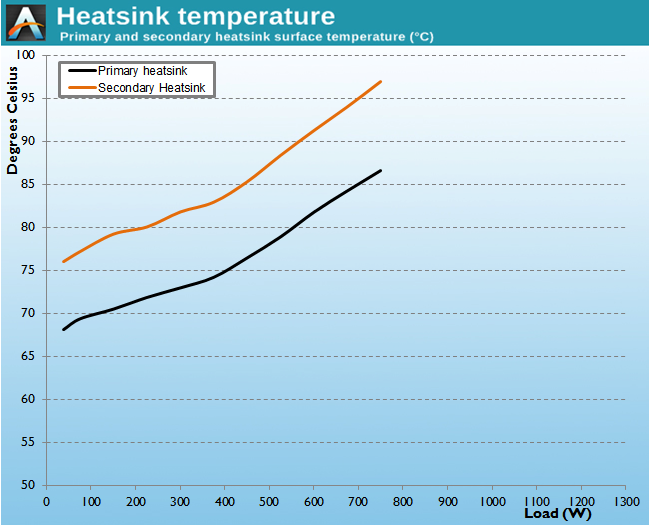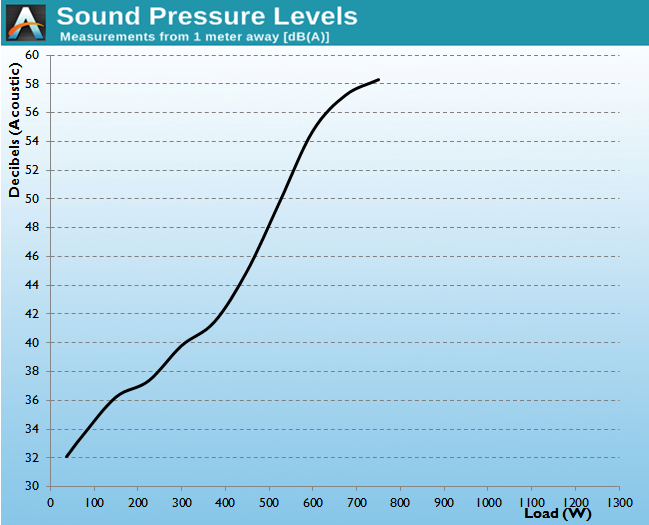The Rosewill Quark Series Power Supply Review (750W, 850W, 1000W, 1200W)
by E. Fylladitakis on January 13, 2016 9:00 AM EST- Posted in
- Cases/Cooling/PSUs
- Rosewill
- 80Plus Platinum
Hot Test Results
Switching over to our hot testing results, as we see in the following tables, the Rosewill Quark PSUs generally offer very good power quality. The maximum ripple on the 12V lines is below 42 mV under full load, with the 750W version displaying weaker filtering than that of the more advanced platforms. The filtering of the 3.3V/5V voltage lines is very good as well, with our maximum reading being 34 mV when the 1200W version was heavily cross-loaded. Voltage regulation is good, at about 2% for the 850W to 1200W version and about 1.4% for the 750W version of the Quark.
| Rosewill Quark 750W - Main Output | ||||||||
| Load (Watts) | 152.03 W | 379.52 W | 563.81 W | 748.51 W | ||||
| Load (Percent) | 20.27% | 50.6% | 75.17% | 99.8% | ||||
| Amperes | Volts | Amperes | Volts | Amperes | Volts | Amperes | Volts | |
| 3.3 V | 1.98 | 3.38 | 4.94 | 3.36 | 7.41 | 3.33 | 9.88 | 3.32 |
| 5 V | 1.98 | 5.16 | 4.94 | 5.13 | 7.41 | 5.09 | 9.88 | 5.05 |
| 12 V | 11.13 | 12.14 | 27.83 | 12.13 | 41.75 | 12.01 | 55.67 | 11.96 |
| Line | Regulation (20% to 100% load) |
Voltage Ripple (mV) | |||||
| 20% Load | 50% Load | 75% Load | 100% Load | CL1 12V |
CL2 3.3V + 5V |
||
| 3.3V | 1.6% | 12 | 12 | 12 | 14 | 14 | 12 |
| 5V | 2% | 14 | 20 | 22 | 22 | 26 | 16 |
| 12V | 1.5% | 30 | 36 | 36 | 40 | 36 | 42 |
| Rosewill Quark 850W - Main Output | ||||||||
| Load (Watts) | 172.7 W | 429.61 W | 635.84 W | 846.17 W | ||||
| Load (Percent) | 20.32% | 50.54% | 74.8% | 99.55% | ||||
| Amperes | Volts | Amperes | Volts | Amperes | Volts | Amperes | Volts | |
| 3.3 V | 2.27 | 3.39 | 5.67 | 3.36 | 8.51 | 3.32 | 11.35 | 3.31 |
| 5 V | 2 | 5.16 | 4.99 | 5.15 | 7.49 | 5.08 | 9.99 | 5.05 |
| 12 V | 12.71 | 12.17 | 31.78 | 12.11 | 47.66 | 11.95 | 63.55 | 11.93 |
| Line | Regulation (20% to 100% load) |
Voltage Ripple (mV) | |||||
| 20% Load | 50% Load | 75% Load | 100% Load | CL1 12V |
CL2 3.3V + 5V |
||
| 3.3V | 2.2% | 10 | 12 | 18 | 22 | 20 | 24 |
| 5V | 2.3% | 10 | 16 | 18 | 26 | 22 | 26 |
| 12V | 2% | 16 | 20 | 26 | 36 | 36 | 30 |
| Rosewill Quark 1000W - Main Output | ||||||||
| Load (Watts) | 203.05 W | 503.92 W | 750.6 W | 996.17 W | ||||
| Load (Percent) | 20.31% | 50.39% | 75.06% | 99.62% | ||||
| Amperes | Volts | Amperes | Volts | Amperes | Volts | Amperes | Volts | |
| 3.3 V | 2.27 | 3.39 | 5.68 | 3.37 | 8.52 | 3.32 | 11.37 | 3.31 |
| 5 V | 2.27 | 5.16 | 5.68 | 5.15 | 8.52 | 5.06 | 11.37 | 5.05 |
| 12 V | 15.09 | 12.17 | 37.74 | 12.07 | 56.6 | 12 | 75.47 | 11.94 |
| Line | Regulation (20% to 100% load) |
Voltage Ripple (mV) | |||||
| 20% Load | 50% Load | 75% Load | 100% Load | CL1 12V |
CL2 3.3V + 5V |
||
| 3.3V | 2.4% | 12 | 16 | 20 | 22 | 20 | 26 |
| 5V | 2.2% | 14 | 18 | 20 | 24 | 20 | 28 |
| 12V | 1.9% | 20 | 22 | 28 | 34 | 36 | 36 |
| Rosewill Quark 1200W - Main Output | ||||||||
| Load (Watts) | 243.25 W | 607.74 W | 902.88 W | 1196.86 W | ||||
| Load (Percent) | 20.27% | 50.65% | 75.24% | 99.74% | ||||
| Amperes | Volts | Amperes | Volts | Amperes | Volts | Amperes | Volts | |
| 3.3 V | 2.31 | 3.38 | 5.79 | 3.38 | 8.68 | 3.33 | 11.57 | 3.32 |
| 5 V | 2.04 | 5.17 | 5.09 | 5.15 | 7.64 | 5.07 | 10.18 | 5.04 |
| 12 V | 18.51 | 12.15 | 46.29 | 12.14 | 69.43 | 12.03 | 92.57 | 11.96 |
| Line | Regulation (20% to 100% load) |
Voltage Ripple (mV) | |||||
| 20% Load | 50% Load | 75% Load | 100% Load | CL1 12V |
CL2 3.3V + 5V |
||
| 3.3V | 1.9% | 14 | 18 | 24 | 26 | 24 | 30 |
| 5V | 2.4% | 16 | 18 | 26 | 30 | 26 | 34 |
| 12V | 1.6% | 20 | 26 | 34 | 38 | 40 | 32 |
Once again, we need to mention that these PSUs are rated at 40°C and we perform our testing at temperatures higher than 45°C - we could reduce the ambient temperature of our hotbox testing but we chose not to do so as the results would then not be comparable to those of our previous reviews.
High ambient temperatures have a significant impact on the electrical performance of the Quark PSUs. The average energy efficiency reduction is 2.5%, with the drop being very high when the units are heavily loaded, reaching 4.3% in the case of the fully loaded 750W version. Considering that these are units rated for operation at 40°C, running them at maximum capacity in higher temperatures are overload conditions for the Quark PSUs, which do well enough maintaining reasonable performance and power quality.

| Efficiency |

| Power Losses |
The internal temperatures per % capacity of the Quark PSUs inside the hotbox are nearly identical between the four units, with all four units reaching almost 100°C under full load. There are measurable thermal performance differences between the units, as the actual difference for a specific load is sometimes more than a few temperature degrees. This is especially true between the 750W version and the more powerful units, which are different platforms.

| Intake & Exhaust Air Temperature |

| Heatsink Temperature |
With such high internal temperatures, it was given that the speed of the fans would greatly increase, as the cooling system would strive to maintain operational temperatures within the units. For the 850W to 1200W versions, all three units display a linear increase of the fan's speed as the load increases, with the noise level reaching up to about 50 dB(A) at maximum load. The 1200W is slightly louder than the other two units, with a maximum of nearly 54 dB(A). What surprised us was the acoustics performance of the 750W version, which is greatly inferior to that of the significantly more powerful units. The rate at which the SPL increases significantly higher, with the 750W unit reaching a maximum of nearly 58 dB(A), making it much louder than the more powerful (and different platform) 850W version. As the speed of the fan was not much greater at this point, we can only surmise that the ball bearing fan of the 750W version has a significantly louder engine or that somehow a much stronger aerodynamic drag is being created by the fan or inside the unit.

| Sound Pressure Level |










34 Comments
View All Comments
Mushkins - Wednesday, January 13, 2016 - link
I was super excited for a Rosewill product with this kind of quality thats *fully modular*, right up until I saw the price point. A Corsair CX750M is about $85 and frequently goes on sale for less or includes $10-15 rebates. Granted it's only 80+ Bronze rated, but the practical differences between a Bronze and a Platinum unit are very small, if not totally meaningless for most people, and certainly isn't worth a $45+ price premium.Honestly, I think Rosewill missed the mark with these pushing for that Platinum rating.
xthetenth - Wednesday, January 13, 2016 - link
They're part of a line, and while the cheap high end is a somewhat limited market, they've got the lower end parts covered, and up until the top if they hit their pricing targets they'll be selling their platinums against other companies' golds and so on down the chain.bigboxes - Wednesday, January 13, 2016 - link
You need to compare these PSUs (pricewise) to other platinum power supplies. If that is out of your budget you can always buy a bronze rated Rosewill if so inclined.zero2dash - Wednesday, January 13, 2016 - link
You're comparing a budget model PSU to a non-budget model PSU. Do you also compare Chevy to Porsche? McDonald's dollar menu to Five Guys?You should instead be comparing this PSU to Corsair HXi and AXi if you want apples to apples.
wolfemane - Wednesday, January 13, 2016 - link
Yes Chevy has been compared to porche for a long time. Corvette and camero come to mind. Price per horse power has put the corvette ahead of more expensive porches. And at those costs, built quality in both are as good as porche but with far lower maintanen costs (and fewer trips to the shop).I think the original comment still stands. On paper these drives have some differences, but in real world application the cheaper psu operates at near or same performance as the premium psu.
So one can brag about owning a porche, but next to a stingray their gonna be smoked and left realizing the only bonus to their more expensive hardware is image. As for me, I'll happily save money and make a porche driver frown.
tuxRoller - Wednesday, January 13, 2016 - link
You're right. A stingray would be left smoking on the railing if it tried to stay with a Porsche on a twisty track.devione - Thursday, January 14, 2016 - link
Really? The ZR1 is only 1+ second slower than a 911 GT2.devione - Thursday, January 14, 2016 - link
On the Nurburgring that is.catzambia - Monday, January 25, 2016 - link
I've run Nordschliefe in 5 minutes in my civicwolfemane - Thursday, January 14, 2016 - link
ZR1 - $70k911 GT2 - $120k
ZR1 (hell even the Z06) has a better 0-60 and 0-100, same times around test tracks, better insurance rating, better maintenance time lines (and a whole lot cheaper), and gets better gas milage.
The ZR1 is faster, quicker, and can corner better than any Porsche at the same price point. It might take Americans a lot longer to figure out how to make a true sports car out of an aging muscle car, but the Corvette is there.
Let me also point out the new style Corvettes (99 and newer) have won 6 LeMans in the past 12 years. That track has corners, and Porsche does compete int he same class. That's a pretty good track record, and one that hasn't been broken yet.